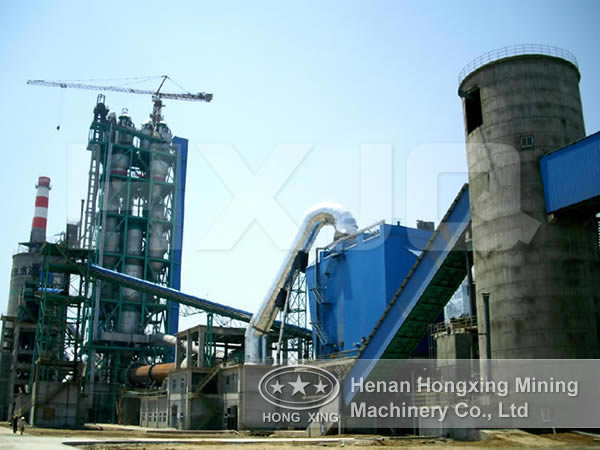


Cement production line is used to produce cement. The complete set of cement equipments in this production line mainly includes jaw crusher, cone crusher, raw material mill, preheater, rotary kiln and cement mill. The detailed production process of cement production line is introduced here.
In the cement production, most of the raw materials need crushing, such as limestone, clay, iron ore, coal, etc. The limestone is of large particle sizes and high hardness after being mined. Therefore, the crushing of the limestone is the most essential part in cement plants.
Pre-homogenization adopts the scientific method of material piling and fetching, making the raw material yard possessing the functions of storage and pre-homogenization.

At least 3 tons of materials need grinding for producing 1 ton of silicate cement (including all kinds of raw materials, such as fuel, clinker, mixture and plaster). According to the statistics, the dry process cement production line consumes more than 60% of the power of the whole plant, with raw material grinding taking up 30%, coal grinding about 3% , cement grinding about 40%. Therefore, the reasonable choice of grinding equipment and process flow, optimized process parameters, correct operation and the manufacturing control system are highly significant to ensure product quality and reduce the energy consumption.
In the new type dry process cement production, stabilizing the ingredients of the raw materials is the precondition of clinker calcining pyrology system. The homogenization system is a final check for the process.
The preheater can finish preheating and partial decomposition, replacing part of the functions of the rotary kiln and shortening its length and enabling the materials to sufficiently mix with the red-hot air. As a result, the contact area is increased, heat transfer rate quickened, the heat transfer efficiency strengthened, fulfilling the purpose of improving production efficiency and reducing heat consumption .
The next procedure is clinker calcination. In the rotary kiln, the carbonate makes further quick decomposition and a series of solid-phase reactions. With the increase in the temperature, the minerals will become liquid and dissolved in the liquid phase reactions and then form a great amount of clinker. After being calcined, the temperature of the clinker will gradually become low. Finally, the hot clinker will be cooled by the Cooler to the appropriate temperature for conveying, storing and grinding. Meanwhile, the heat will be recycled, thus the heat efficiency improved and clinker quality enhanced.
As the last process, it is also the most power-consuming process. Its main function exists in grinding cement clinker (also gelling agent, performance adjustment materials, etc.) to the proper sizes, forming a certain grain gradation, increasing hydration area and speeding up hydration rate, meeting the requirements of condensation and hardening of the cement slurry.
You can also send a message to us by this email sales@hxjq.com, we will reply to you within 24 hours. Now tell us your needs, there will be more favorable prices!
You can also send a message to us by this email sales@hxjq.com, we will reply to you within 24 hours. Now tell us your needs, there will be more favorable prices!